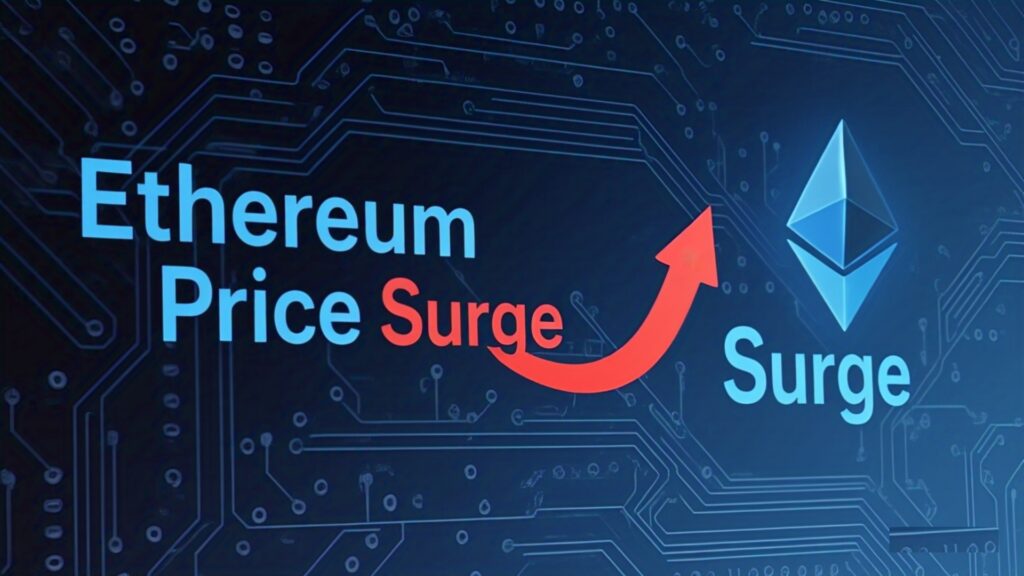Ethereum is the second-largest cryptocurrency by market capitalization. Its price Surge (ETH) has lately shown an encouraging positive signal that attracts traders and investors. Ethereum’s price movement points to a possible upward path within a larger market marked by economic uncertainty, regulatory scrutiny, and changing investor mood. Still, the challenge is whether this momentum can withstand technical, macroeconomic, and blockchain-specific hurdles.
A technical indicator known as a golden crossover, where the 50-day moving average crosses over the 200-day moving average, has been displayed on the Ethereum price chart lately. Historically, this trend has been seen as a significant positive indication in the crypto sphere and conventional financial markets. Still, the presence of bullish indications won’t be enough to propel Ethereum’s price beyond resistance thresholds. Knowing the forces at work—from Ethereum’s shift to proof-of-stake, gas fee optimization, and DeFi sector trends—adds essential background to the present surge.
Technical Signs and Market Momentum
Ethereum lately stayed close to the $3,500 resistance zone, pushing past the $3,200 support level and generating rumors of an approaching breakout. Rising trade volumes on big exchanges like Binance, Coinbase, and Kraken helped to confirm this positive message. Rising above 60, the Relative Strength Index (RSI) indicates increasing purchasing activity but does not yet signal overbought circumstances.
Glassnode and IntoTheBlock blockchain data show increased accumulation by Ethereum whales—wallets carrying over 10,000 ETH. This activity is usually associated with a long-term, optimistic attitude. On-chain data show a clear drop in ETH balances on centralized exchanges, implying a tendency to HODL, often preceded by price increases due to lower market supply.
The Function of Proof-of-Stake Validation with Ethereum 2.0
The success of the Merge and the continuous Ethereum 2.0 update are key elements supporting Ethereum’s possibility for a constant bull run. Ethereum has drastically cut energy consumption—over 99.5% according to the Ethereum Foundation—from proof-of-work (PoW) to proof-of-stake (PoS). This improves its ESG (Environmental, Social, Governance) profile and appeals to institutional investors concentrating on sustainable investing.

With over 33 million ETH already stashed, validator growth on the Beacon Chain stays constant. Like share buybacks in equity markets, this staking system lowers the circulating supply and functions as a price-supportive mechanism. Moreover, the forthcoming Dencun upgrade, which will bring proto-danksharding to maximize data availability, is projected to increase scalability and lower gas costs—a recurring issue for customers and dApp developers equally.
DeFi Renewal and institutional acceptance
It is impossible to analyze Ethereum’s price movement apart from the larger decentralized finance (DeFi) ecosystem. Representing billions of dollars in total value locked (TVL), leading DeFi protocols, including Aave, MakerDAO, and Uniswap, keep building atop Ethereum’s infrastructure. With Ethereum owning over 60% of total TVL, recent data from DefiLlama demonstrates its supremacy in the DeFi sector remains unopposed.
Another trend is institutional adoption. Companies like BlackRock and JPMorgan have aggressively sought Ethereum-based solutions to tokenize actual assets and enable cross-border settlements. Major companies like Microsoft and EY are still being onboarded by the Ethereum Enterprise Alliance (EEA), confirming the network’s value outside speculative trade.
Regulatory Clouds and Market Attitudes
Ethereum suffers significant headwinds, notwithstanding these encouraging signals. According to the U.S. Securities and Exchange Commission (SEC), whether Ethereum qualifies as a security remains unclear. Recent legal issues, including the SEC’s continuous litigation with Coinbase, have raised market fears. The introduction of Ethereum Spot ETFs, presently under consideration by the SEC, which would be a game-changer for institutional access if authorized, could be affected by regulatory ambiguity.
Furthermore, geopolitical concerns, growing interest rates, and inflationary pressures worldwide influence a risk-on attitude. Under such macroeconomic circumstances, Ethereum and other crypto assets sometimes correlate with tech equities, which drives more volatility. Platforms for market information like Santiment and Messari indicate that retail attitudes are still unstable but generally cautiously positive.
Threats from Competent Layers 1 and 2 Blockchains
Although Ethereum is still the most often used Layer 1 platform, faster, less expensive substitutes such as Solana, Avalanche, and Aptos are increasingly challenging. These networks challenge Ethereum’s market dominance since they provide better throughput and lower transaction fees. However, Ethereum’s Layer 2 ecosystem—which consists of Optimism, Arbitrum, Base, and zkSync—serves as a vital counterpoint to this competitiveness.
While maintaining decentralization and security, layer two scaling methods seek to increase Ethereum’s transaction capability. With almost $20 billion spanning these networks, L2Beat data reveals a tremendous increase in Layer 2 utilization. Successful integration with Ethereum Layer 1 and ongoing adoption can help the network keep its competitive edge.
Can Ethereum Overcome Obstacles?
Several important factors must coincide for Ethereum to overcome the psychological resistance of $4,000 and retest its all-time high close to $4,900. These include on-chain utility, ongoing institutional inflows, exemplary implementation of forthcoming enhancements, and beneficial legislative changes.
Usually, market cycles and basic developments have driven Ethereum Price Surge swings. For example, the proliferation of NFTs, DeFi, and a favorable macro environment drove the 2021 bull run. By comparison, Ethereum’s present price path seems more fundamentally anchored based on better fundamentals rather than hype.
From DeFi and NFTs to gaming, artificial intelligence, and tokenized securities, Ethereum’s long-term bright future depends on its capacity to develop into a completely scalable, distributed global computer capable of supporting a broad spectrum of applications.


